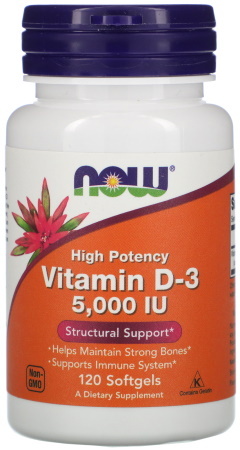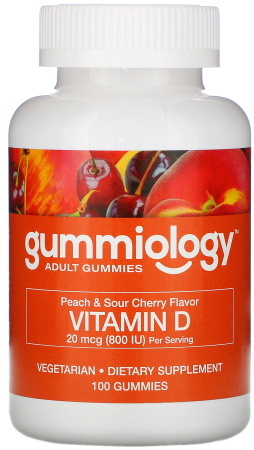Replenishment of the deficit Vitamin D, calcium and phosphorus compounds in a woman's body helps to strengthen and maintain a healthy bone tissue. It is used to treat diseases of the musculoskeletal system (rickets, softening of bones, osteoporosis). It is produced by skin cells when exposed to sunlight (UV radiation).
Record content:
- 1 What is vitamin D for women?
- 2 Role of Vitamin D
- 3 What diseases does a lack of Vitamin D lead to?
- 4 Daily intake of vitamin D in women (depending on age)
- 5 During pregnancy
- 6 Diet to replenish vitamin deficiency
- 7 Preparations with vitamin D
- 8 Vitamin and mineral complexes
- 9 Sunbathing and lifestyle
- 10 Vitamin D video
What is vitamin D for women?
Vitamin D (ergocalciferol-D2, cholecalciferol-D3, alfacalcidol) is a fat-soluble vitamin that assists in the absorption of calcium and phosphorus compounds. The reasons for not getting enough Vitamin D are sunscreens, lack of sunlight, dark skin and age-related changes in skin cells.
Vitamin D is used together with other drugs to compensate for calcium or phosphate deficiencies caused by certain disorders of the body, such as decreased secretion of the parathyroid glands, pseudohypoparathyroidism, hereditary hypophosphatemia.
Vitamin D drops are recommended for breastfed babies, since the vitamin D content in breast milk is insufficient.
Vitamin D belongs to the group of four fat-soluble vitamins, but technically it is not a vitamin, because, unlike substances that are classified as vitamins, it is produced in the body. In products other than fish and egg yolk, as well as after entering the body from food, it must be transformed into a form that is useful for the body.
Role of Vitamin D
Vitamin D is several chemical compounds. The natural form is formed in the skin from 7-dehydrocholesterol. Ultraviolet light plays a key role in this transformation: under the influence of UV-B energy, the precursor is converted into vitamin D3. D3 is transferred to the liver, then to the kidneys, where the active form of the vitamin is formed.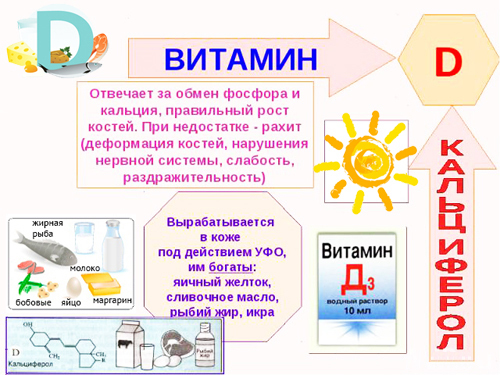
Vitamin D2 is formed by the action of ultraviolet energy from plant sterol, which comes from dietary supplements. D2 and D3 perform the same function, therefore they are combined under the name Vitamin D.
In the liver, Vitamin D captures oxygen and hydrogen molecules, forms 25-hydroxyvitamin D or 25 (OH) D. It is this compound that is measured to diagnose Vitamin D deficiency. In the kidneys, 25-hydroxyvitamin D produces 25-dihydroxyvitamin D 1,25 (OH) 2D or calcitriol, which is the active form of vitamin D.
Vitamin D helps maintain healthy bones by increasing intestinal absorption of calcium. With a lack of Vitamin D, the body absorbs from 10 to 15% of calcium, which is ingested with food, while with a normal level of Vitamin D, 30-40% of calcium is absorbed.
With a lack of Vitamin D, children develop rickets, and adults develop bone softening syndrome. Both syndromes are now quite rare, but the number of cases of osteoporosis, which leads to fractures and deformities of the spine, is increasing.
Low Vitamin D levels lead to a lack of calcium in the bones and the risk of bone fractures. But strengthening bones is not the only function of Vitamin D, it plays a very important role in others. processes, including reducing inflammation, controlling cell growth, neuromuscular and immune function.
Most tissues in the body contain Vitamin D receptors, proteins that bind to Vitamin D.
In the intestine, the receptors capture Vitamin D, which ensures better absorption of calcium. But the same receptors are found in other organs: in the heart, blood vessels, muscles, endocrine glands, Vitamin D binds to these receptors and affects the work of various organs. Therefore, it is very important to have enough Vitamin D.
What diseases does a lack of Vitamin D lead to?
A decrease in the level of Vitamin D occurs with a lack of sunlight, as well as in people with severe skin pigmentation. In case of intestinal disorders, the absorption of fats, including fat-soluble Vitamin D, worsens. The impairment of the conversion of Vitamin D to its active form of calcitriol is associated with diseases of the kidneys or liver.
Certain medications are also known to decrease the activity or availability of Vitamin D. The risk of vitamin D deficiency is also increased in healthy adults in adulthood. Due to these factors, Vitamin D deficiency is very common and accounts for 41% among the population aged 49 to 83 years, as well as about 30% among the population aged 18 to 29 years.
- Osteoporosis and bone fracture.
Without enough Vitamin D, the intestine absorbs calcium poorly. The amount of calcium in the blood is critical for neuromuscular and cardiac function, the body does not allow the level of calcium to fall.
Parathyroid hormone is released, which releases calcium from the bones. Calcium levels in the blood remain normal, so the heart and nervous system function normally, bones lose calcium and become fragile.
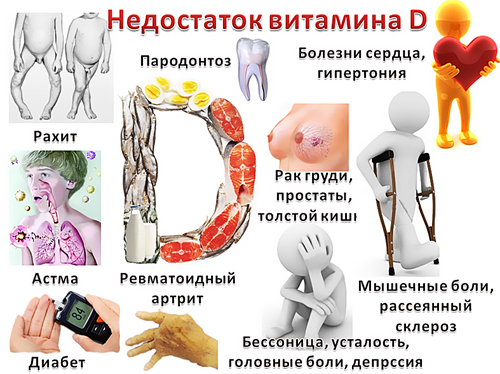
Most studies have shown that a lack of Vitamin D increases the risk of osteoporosis and the likelihood of fractures. There is significant controversy over how much supplementation reduces the risk of fractures, with some studies using 400 IU per day and others with 800 IU per day.
- Malignant formations.
Vitamin D plays an important role in the regulation of cell growth. It prevents the uncontrolled proliferation of cells characteristic of cancer, reduces cell division, limits blood supply to the tumor, increases apoptosis (death of cancer cells) and limits the spread of cancer cells (metastasis).
The risk of colon cancer, breast cancer and other malignant neoplasms appears to increase in populations living in latitudes far from the equator. Sun exposure and Vitamin D levels may be one of the reasons.
Although clinical trials have not shown a reduction in the risk of cancer with vitamin D supplementation, a daily dose of 1,000 IU of vitamin D has been shown to reduce cancer mortality.
Some studies have identified a relationship between vitamin D deficiency and diagnoses such as Alzheimer's syndrome and cancer. That is, patients with these diseases have a low level of Vitamin D in the blood. However, this is only a relationship, but not necessarily the cause of the disease.
That is, insufficient data have been obtained to assert that vitamin deficiency is the cause of the disease. There is also insufficient evidence to suggest that taking Vitamin D supplements will reduce the development of these conditions.
Daily intake of vitamin D in women (depending on age)
It is recommended to replenish Vitamin D in a woman's body if the level of 25 (OH) D in the blood is below 20 ng / ml, this is a pronounced Vitamin D deficiency. If the level of 25 (OH) D is 20 to 30 ng / ml, you should consult your doctor, as this condition is between deficiency and normal.
According to data presented on the website of the National Institutes of Health (USA), serum 25 (OH) D less than 12 ng / ml is associated with vitamin D deficiency, which leads to rickets in children and softening of bones in adults. 12 to 20 ng / ml is insufficient for healthy bones. More than 50 ng / ml Vitamin D can also cause adverse health effects.
The optimal concentration of 25 (OH) D required for the normal state of bones and the general condition of the body has not been established, since it depends on age, race and lifestyle.
Until 1997 the recommended dose of Vitamin D was 200 IU for adults at any age. After the deficiency of Vitamin D was recorded, the dose was increased: for 51-70 year olds up to 400 IU and up to 600 IU for patients over 70 years old. Some experts recommend 800 or 1000 IU per day.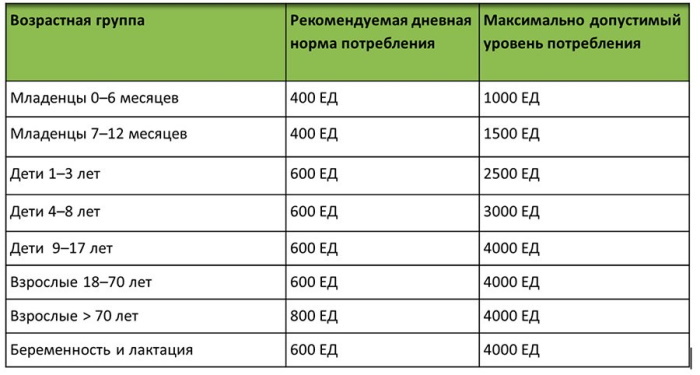
Replenish the body with Vitamin D, according to data presented on the website of the National Institutes of Health (USA) you can use the following recommended dosages for women:
| Age | Quantity, IU | Pregnancy | Lactation |
| 0-12 months | 400 | ||
| 1-13 years old | 600 | ||
| 14-18 years old | 600 | 600 | 600 |
| 19-50 years old | 600 | 600 | 600 |
| 51-70 years old | 600 | ||
| More than 70 years | 800 |
The average need for Vitamin D in patients aged 800-1000 IU per day. It is possible to increase the daily allowance to 2000 IU per day for patients who are overweight, diagnosed with osteoporosis or for patients who have little are in the air (for example, for those who cannot leave the house, living in special institutions), for patients with a violation suction.
Like other fat-soluble vitamins, Vitamin D is stored in adipose tissue. This means that the body can use its own reserves if the daily intake is temporarily interrupted, but it also means that an excess dose of Vitamin D can build up to toxic levels.
At these levels, Vitamin D can increase blood calcium levels to levels that cause dizziness, stomach obstruction, and even death. But to achieve toxicity, a large overdose is necessary, doses up to 2000 IU per day are considered safe.
To determine the level of Vitamin D, the concentration of form 25 (OH) D in the blood serum is measured. This value reflects the content of its own Vitamin D and the concentration of the vitamin obtained in the form of vitamin complexes and supplements. Determination of the concentration of 25 (OH) D is complicated by the fact that laboratories use different methods of analysis.
The most common are 2 methods - using antibodies and chromatographic. As a result, erroneously underestimated and overestimated values can be obtained, depending on the method of determination and the laboratory.
During pregnancy
Vitamin D deficiency is common in pregnant women. The lack of this vitamin is associated with an increased risk of developing preeclampsia, gestational diabetes mellitus, and premature birth.
Vitamin D supplementation during pregnancy improves the condition and may reduce the risk of preeclampsia, low birth weight, and premature birth.
However, the World Health Organization (WHO) does not recommend administering Vitamin D to pregnant women, as studies, showing directly the benefits and harms of only vitamin D supplementation for improving maternal and child health outcomes not enough.
As a source of Vitamin D, a complete healthy diet is recommended, as well as sunbathing. On the other hand, nutritional guidelines for pregnant women published on the American Pregnancy Association state the need to monitor vitamin D levels in pregnant women.
You can replenish Vitamin D in a woman's body during pregnancy by taking 4000 IU of vitamin per day. This dose is considered safe for both the pregnant woman and the baby and reduces the risk of premature birth and infection. Since vitamin complexes for pregnant women contain only 400 IU of Vitamin D, it is recommended to take it daily as a supplement.
Diet to replenish vitamin deficiency
It is quite difficult to replenish Vitamin D in a woman's body with a diet. Vitamin D is found in few foods. The best source of vitamin is considered to be fillets of oily fish (trout, salmon, tuna, mackerel) or fish oil.
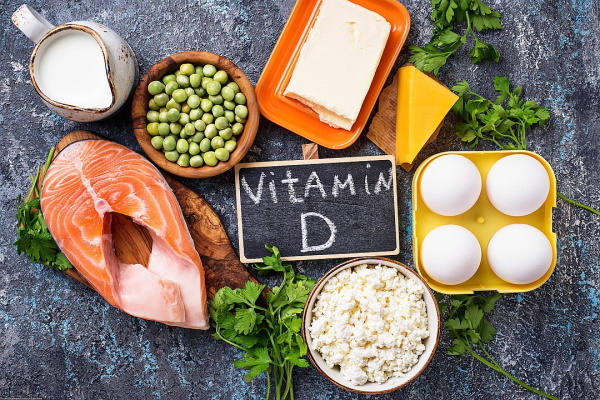
A small amount of vitamin D in the form of D3, D2 and metabolite 25 (OH) D3 is found in products such as:
- beef liver;
- crustaceans;
- shellfish;
- cheese;
- egg yolks;
- mushrooms.
When studying the bioavailability of Vitamin D obtained from different products, no significant differences were found.
Several types of mushrooms on the market have been treated with UV light to increase their Vitamin D2 content. Food and Drug Administration approves drugs from UV-treated mushrooms in powder form as a food additive that can be used as a source of Vitamin D2.
Getting Vitamin D from food alone is difficult enough, to replenish 400 IU of Vitamin D you need to eat about 5 ounces of salmon, 7 ounces of halibut, 30 ounces of cod. Egg yolk contains about 20 IU of Vitamin D, but the yolk also contains almost the daily intake of cholesterol, so it is not recommended to use the yolk to replenish the daily intake of Vitamin D.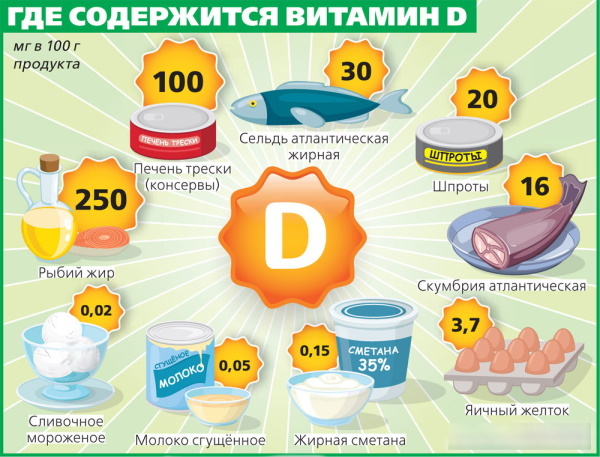
The rest of the foods contain much less of this vitamin, which is why manufacturers add vitamin D to milk, some yoghurts, organic juice and cereals.
The average serving of the product contains about 100 IU, that is, you need to consume about 1 liter of milk to replenish the 400 IU portion of Vitamin D. Cod liver is rich in Vitamin D, but it also contains too much Vitamin A to be consumed daily.
Preparations with vitamin D
During pregnancy, lactation, in the presence of chronic diseases of the kidneys, thyroid gland, it is recommended to take preparations containing Vitamin D with caution, after consultation with the treating person a doctor.
Most dietary supplements contain Vitamin D3, also known as cholecalciferol. According to some studies, this form increases blood levels of the vitamin slightly better than vitamin D2 (ergocalciferol). Both of these forms of the vitamin are processed in the liver and kidneys.
Ergocalciferol and cholecalciferol differ chemically in the structure of the side chains. Both forms are well absorbed in the small intestine. The simultaneous presence of fats in the intestine increases the absorption of Vitamin D, but a certain amount of the vitamin is absorbed without fats.
For people with kidney and liver diseases, special supplements must be taken, which are prescribed by the attending physician.
| Brand name | Peculiarities | price, rub. |
| Now Foods |
|
524 |
| California Gold Nutrition |
|
318,5 |
| Nature's Answer |
|
1074 |
| Solgar |
|
1014 |
| Sports Research |
|
395 |
Vitamin and mineral complexes
Vitamin D can be replenished in a woman's body with the help of vitamin supplements. A daily multivitamin contains the required 400 IU of Vitamin D. You need to carefully study the label to make sure that the amount of Vitamin D is sufficient, and not exceeding the norm or too little.
| Brand name | Peculiarities | price, rub. |
| Gummiology |
|
638 |
| Natural factors |
|
2119 |
| Ultamins |
|
2393 |
| Nature's Answer |
|
1136 |
With a daily intake of Vitamin D in a small dose of up to 1000 IU, it is very unlikely that the level of Vitamin D in the blood will be too low or too high. Therefore, a test for the content of Vitamin D is usually not prescribed.
However, if an acute Vitamin D deficiency has been diagnosed, the attending physician may recommend a higher dose of vitamin D supplementation. After that, it is usually recommended to repeat the test for the content of Vitamin D in the blood after 3-4 months of taking vitamin supplements. Usually, the definition of level 25 (OH) D is prescribed.
Sunbathing and lifestyle
Several factors influence the lack of vitamin D levels. The main reason for a lack of this vitamin is a lack of sunlight. At latitudes far from the equator, there is not enough sunlight to produce normal levels of Vitamin D, except for a few summer months.
In addition, most modern people spend most of their time indoors or use sunscreens for their skin, protecting themselves from the negative effects of ultraviolet radiation. To make up for the lack of Vitamin D, it is recommended to use vitamin complexes and food supplements.
Sunlight contains two types of UV rays, ultraviolet A (UVA) and ultraviolet B (UVB). UVB is necessary for the production of Vitamin D, but it also damages skin cells and can lead to skin cancer. UVA also damages cells and leads to premature skin aging.
To protect against the harmful effects of UV curing, avoid sunlight during the summer, especially between 10 and 14 o'clock, and cover body parts with clothing and wear a hat. You should use products with an SPF of at least 15 units, people with fair skin are advised to use products with an SPF of 30 or more.
It is also necessary that the sunscreen protects not only from B rays, but also from UV A rays, on such products it is generally stated to be "broad spectrum" UV protection, it must contain titanium dioxide, zinc oxide or avobenzone.
In order to replenish the insufficient level of Vitamin D in a woman's body, you can start eating more food containing this vitamin, more being outdoors in the sun. Sufficient insolation time: 5-10 min. a day, 2-3 times a week with open areas of the body (arms, legs, face).
Vitamin D video
How important is vitamin D:

